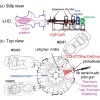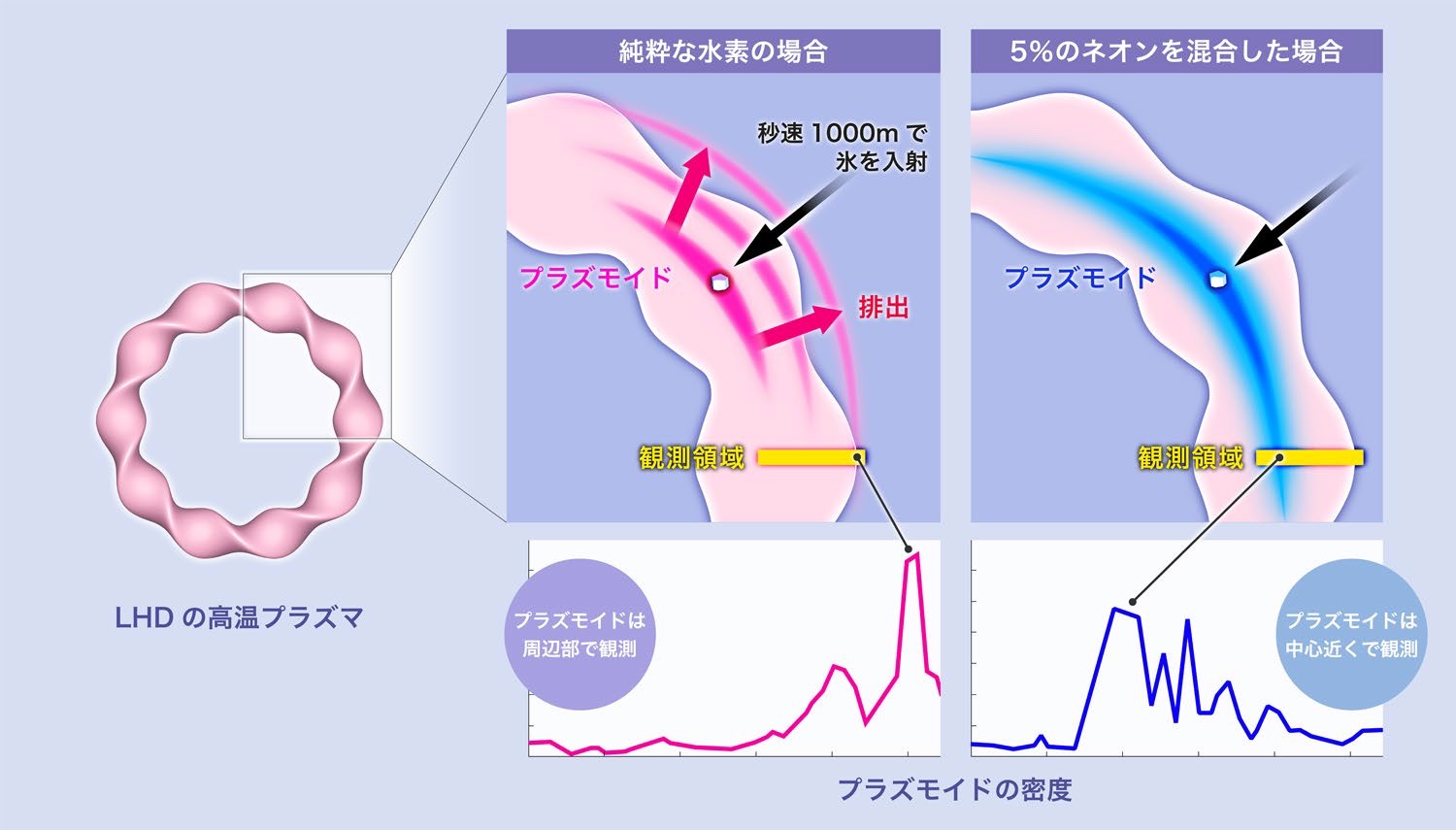

億度等離子體:用冰粒冷卻ITER!
ー 日本國立量子放射科學技術研究所提供冷卻技術 ー
國家量子與放射科學技術研究院:
-大型螺旋裝置(LHD)實驗-
在受磁場約束的高溫等離子體中,
如果注入添加氖的氫冰粒,
我們已經證明,高溫等離子體可以有效地冷卻到深處。
實驗聚變反應堆 ITER (ITER):
-針對高溫等離子體不穩定的措施-
對於ITER,需要“強製冷卻高溫等離子體的技術”。
這一次,我們闡明了“影響 ITER 運行所必需的冷卻系統的影響”。
概述:
– 法國正在建設中的聚變實驗堆(ITER) –
“被磁場限制的高溫等離子體變得不穩定並被釋放。”
它可能會干擾核聚變實驗的執行。
需要針對稱為“中斷”的現象採取對策。
等離子強製冷卻技術:
(中斷緩解)
日本國家量子和放射科學技術研究所開發了這項技術。
有可能“捕捉不穩定跡象並強力冷卻等離子體”。
添加霓虹燈:
添加了“氫冰中約 5% 的氖”。
與入射的純氫冰相比,
我們闡明了可以冷卻到等離子體的深處。
– 國家量子與放射科學技術研究院
https://www.qst.go.jp/site/press/20221223.html
Plasma à 100 millions de degrés : Refroidir ITER avec des grains de glace !
ー Les instituts nationaux japonais pour la science et la technologie quantiques et radiologiques fournissent une technologie de refroidissement ー
Instituts nationaux des sciences et technologies quantiques et radiologiques :
-Expérience de grand dispositif hélicoïdal (LHD)-
Dans un plasma à haute température confiné par un champ magnétique,
Si vous injectez des grains de glace à l’hydrogène additionnés de néon,
Nous avons démontré que le plasma à haute température peut être efficacement refroidi en profondeur.
Réacteur de Fusion Expérimental ITER (ITER):
-Mesures contre l’instabilité du plasma à haute température-
Pour ITER, une “technologie de refroidissement forcé du plasma à haute température” est requise.
Cette fois, nous avons précisé les “effets qui influencent le système de refroidissement indispensable au fonctionnement d’ITER”.
Aperçu:
– Réacteur expérimental à fusion (ITER) en construction en France –
“Le plasma à haute température confiné par un champ magnétique devient instable et est libéré.”
Il peut interférer avec l’exécution d’expériences de fusion nucléaire.
Des contre-mesures contre le phénomène appelé « disruption » sont nécessaires.
Technologie de refroidissement forcé du plasma :
(atténuation des perturbations)
Les instituts nationaux japonais des sciences et technologies quantiques et radiologiques ont développé la technologie.
Il est possible “d’attraper des signes d’instabilité et de forcer le refroidissement du plasma”.
Ajouter du néon :
Ajout de “environ 5 % de néon à de la glace d’hydrogène”.
Par rapport à la glace d’hydrogène pur incidente,
Nous avons précisé qu’il est possible de refroidir jusqu’à la partie profonde du plasma.
– Instituts nationaux des sciences et technologies quantiques et radiologiques
100-Millionen-Grad-Plasma: ITER mit Eiskörnern kühlen!
ー Japans National Institutes for Quantum and Radiological Science and Technology bieten Kühltechnologie ー
National Institutes for Quantum and Radiological Science and Technology:
-LHD-Experiment (Large Helical Device)-
In einem von einem Magnetfeld eingeschlossenen Hochtemperaturplasma
Wenn Sie mit Neon versetzte Wasserstoffeiskörner injizieren,
Wir haben gezeigt, dass Hochtemperaturplasmen effektiv bis in die Tiefe gekühlt werden können.
Experimenteller Fusionsreaktor ITER (ITER):
-Maßnahmen gegen Instabilität des Hochtemperaturplasmas-
Für ITER wird „Technologie zur Zwangskühlung von Hochtemperaturplasma“ benötigt.
Diesmal haben wir die „Auswirkungen, die das für den ITER-Betrieb wesentliche Kühlsystem beeinflussen“ geklärt.
Überblick:
– Fusion Experimental Reactor (ITER) im Bau in Frankreich –
“Durch ein Magnetfeld eingeschlossenes Hochtemperaturplasma wird instabil und wird freigesetzt.”
Es kann die Durchführung von Kernfusionsexperimenten stören.
Gegenmaßnahmen gegen das Phänomen „Disruption“ sind notwendig.
Technologie zur Zwangskühlung von Plasma:
(Störungsminderung)
Die Technologie wurde von den japanischen National Institutes for Quantum and Radiological Science and Technology entwickelt.
Es ist möglich, “Anzeichen von Instabilität zu erkennen und das Plasma gewaltsam abzukühlen”.
Neon hinzufügen:
„etwa 5 % Neon zu Wasserstoffeis“ hinzugefügt.
Im Vergleich zu einfallendem reinem Wasserstoffeis
Wir haben klargestellt, dass es möglich ist, bis in den tiefen Teil des Plasmas abzukühlen.
– National Institutes for Quantum and Radiological Science and Technology
Enhanced Material Assimilation in a Toroidal Plasma Using Mixed H2+NePellet Injection and Implications to ITER
Phys. Rev. Lett. 129, 255001 (2022) –
ABSTRACT
The ablation and assimilation of cryogenic pure H 2 and mixed H 2 + Ne pellets,
which are foreseen to be used by the ITER tokamak for mitigating thermal and electromagnetic loads of major disruptions,
are observed by spatially and temporally resolved measurements.
It is experimentally demonstrated that
a small fraction (here ≈ 5 % ) of neon added to hydrogenic pellets enhances the core density assimilation with reduced outward transport for the low magnetic-field side injection.
This is consistent with theoretical expectations that
line radiation increased by doped neon in dense plasmoids suppresses the plasmoid pressure and reduces the → E × → B transport of the ablated material.